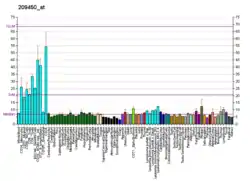OSGEP
Probable O-sialoglycoprotein endopeptidase is an enzyme that in humans is encoded by the OSGEP gene.[4][5]
References
- GRCh38: Ensembl release 89: ENSG00000092094 - Ensembl, May 2017
- "Human PubMed Reference:". National Center for Biotechnology Information, U.S. National Library of Medicine.
- "Mouse PubMed Reference:". National Center for Biotechnology Information, U.S. National Library of Medicine.
- Seki Y, Ikeda S, Kiyohara H, Ayabe H, Seki T, Matsui H (May 2002). "Sequencing analysis of a putative human O-sialoglycoprotein endopeptidase gene (OSGEP) and analysis of a bidirectional promoter between the OSGEP and APEX genes". Gene. 285 (1–2): 101–8. doi:10.1016/S0378-1119(02)00429-8. PMID 12039036.
- "Entrez Gene: OSGEP O-sialoglycoprotein endopeptidase".
Further reading
- Andersson B, Wentland MA, Ricafrente JY, et al. (1996). "A "double adaptor" method for improved shotgun library construction". Anal. Biochem. 236 (1): 107–13. doi:10.1006/abio.1996.0138. PMID 8619474.
- Vickers JD, Packham MA, Kinlough-Rathbone RL (1997). "Differences between platelet phosphoinositide metabolism stimulated by thrombin or SFLLRN are not accounted for by interaction of thrombin with glycoprotein Ib". Am. J. Hematol. 54 (4): 288–95. doi:10.1002/(SICI)1096-8652(199704)54:4<288::AID-AJH5>3.0.CO;2-R. PMID 9092683.
- Yu W, Andersson B, Worley KC, et al. (1997). "Large-Scale Concatenation cDNA Sequencing". Genome Res. 7 (4): 353–8. doi:10.1101/gr.7.4.353. PMC 139146. PMID 9110174.
- Chervenak JL, Illsley NP (2000). "Episialin acts as an antiadhesive factor in an in vitro model of human endometrial-blastocyst attachment". Biol. Reprod. 63 (1): 294–300. doi:10.1095/biolreprod63.1.294. PMID 10859271.
- Kinoshita M, Nakamura T, Ihara M, et al. (2001). "Identification of human endomucin-1 and -2 as membrane-bound O-sialoglycoproteins with anti-adhesive activity". FEBS Lett. 499 (1–2): 121–6. doi:10.1016/S0014-5793(01)02520-0. PMID 11418125.
- Armerding D, Fuhlbrigge RC, Kieffer JD, Kupper TS (2001). "Tonsillar B cells do not express PSGL-1, but a significant fraction displays the cutaneous lymphocyte antigen and exhibits effective E- and P-selectin ligand activity". Int. Arch. Allergy Immunol. 126 (1): 78–90. doi:10.1159/000049497. PMID 11641609.
- Strausberg RL, Feingold EA, Grouse LH, et al. (2003). "Generation and initial analysis of more than 15,000 full-length human and mouse cDNA sequences". Proc. Natl. Acad. Sci. U.S.A. 99 (26): 16899–903. doi:10.1073/pnas.242603899. PMC 139241. PMID 12477932.
- Ota T, Suzuki Y, Nishikawa T, et al. (2004). "Complete sequencing and characterization of 21,243 full-length human cDNAs". Nat. Genet. 36 (1): 40–5. doi:10.1038/ng1285. PMID 14702039.
- Gerhard DS, Wagner L, Feingold EA, et al. (2004). "The Status, Quality, and Expansion of the NIH Full-Length cDNA Project: The Mammalian Gene Collection (MGC)". Genome Res. 14 (10B): 2121–7. doi:10.1101/gr.2596504. PMC 528928. PMID 15489334.
- Rual JF, Venkatesan K, Hao T, et al. (2005). "Towards a proteome-scale map of the human protein-protein interaction network". Nature. 437 (7062): 1173–8. doi:10.1038/nature04209. PMID 16189514.
- Ewing RM, Chu P, Elisma F, et al. (2007). "Large-scale mapping of human protein–protein interactions by mass spectrometry". Mol. Syst. Biol. 3 (1): 89. doi:10.1038/msb4100134. PMC 1847948. PMID 17353931.
This article is issued from Wikipedia. The text is licensed under Creative Commons - Attribution - Sharealike. Additional terms may apply for the media files.


